
The Volunteer Officers' Decoration, post-nominal letters VD, was instituted in 1892 as an award for long and meritorious service by officers of the United Kingdom's Volunteer Force. Award of the decoration was discontinued in the United Kingdom when it was superseded by the Territorial Decoration in 1908, but it continued to be awarded in some Crown Dependencies until 1930.
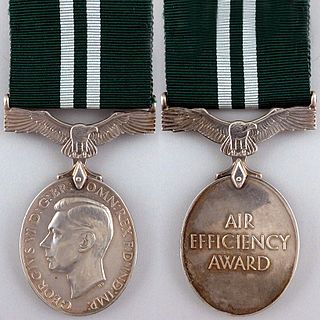
The Air Efficiency Award, post-nominal letters AE for officers, was instituted in 1942. It could be awarded after ten years of meritorious service to officers, airmen and airwomen in the Auxiliary and Volunteer Air Forces of the United Kingdom and the Territorial Air Forces and Air Force Reserves of the Dominions, the Indian Empire, Burma, the Colonies and Protectorates.

The John Chard Decoration, post-nominal letters JCD, was a military long service decoration which was instituted by the Union of South Africa on 6 April 1952. It was awarded to members of the Citizen Force of the South African Defence Force for twenty years of efficient service and good conduct. Clasps could be awarded after thirty and forty years service respectively.
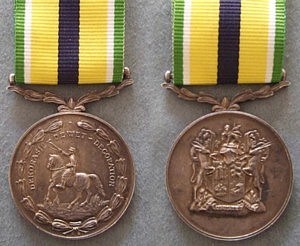
The De Wet Decoration, post-nominal letters DWD, is a military long service decoration which was instituted by the Republic of South Africa in 1965. It could be awarded to members of the Commandos, the rural civil defence component of the South African Defence Force, for twenty years of efficient service and good conduct. The decoration was initially reserved for officers, but it was made available to all ranks in 1986. A clasp could be awarded after thirty years service.
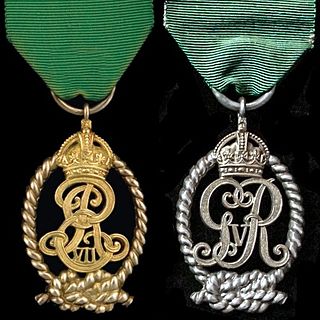
The Decoration for Officers of the Royal Naval Volunteer Reserve, post-nominal letters VD until c. 1947 and VRD thereafter, was instituted in 1908. It could be awarded to part-time commissioned officers in the United Kingdom's Royal Naval Volunteer Reserve after twenty years of service as efficient and thoroughly capable officers. The decoration was a Naval version of the Volunteer Officers' Decoration and its successor, the Territorial Decoration.
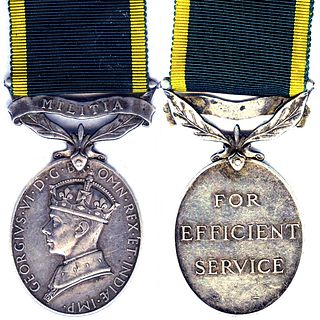
The Efficiency Medal was instituted in 1930 for award to part-time warrant officers, non-commissioned officers and men after twelve years of efficient service on the active list of the Militia or the Territorial Army of the United Kingdom, or of the other Auxiliary Military Forces throughout the British Empire. At the same time a clasp was instituted for award to holders of the medal upon completion of further periods of six years of efficient service.
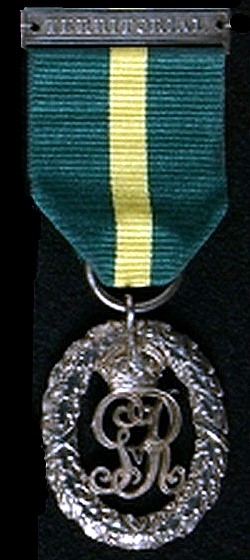
The Efficiency Decoration, post-nominal letters TD for recipients serving in the Territorial Army of the United Kingdom or ED for those serving in the Auxiliary Military Forces, was instituted in 1930 for award to part-time officers after twenty years of service as an efficient and thoroughly capable officer. The decoration superseded the Volunteer Officers' Decoration, the Colonial Auxiliary Forces Officers' Decoration and the Territorial Decoration.
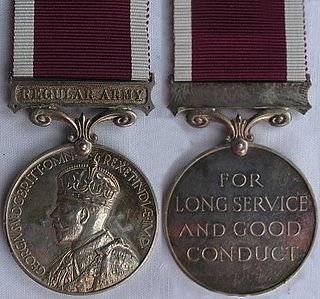
The Medal for Long Service and Good Conduct (Military) is a medal awarded to regular members of the armed forces. It was instituted by King George V in 1930 and replaced the Army Long Service and Good Conduct Medal as well as the Permanent Forces of the Empire Beyond the Seas Medal. The medal was originally awarded to Regular Army warrant officers, non-commissioned officers and men of the UK Armed Forces. It also had a number of territorial versions for the Permanent Forces of the British Dominions. The eligibility criteria were relaxed in 1947 to also allow the award of the medal to officers who had served a minimum period in the ranks before being commissioned. Since 2016, the eligibility was widened to include officers who had never served in the ranks, and so the medal can now be awarded to all regular members of the British Armed Forces who meet the required length of service.
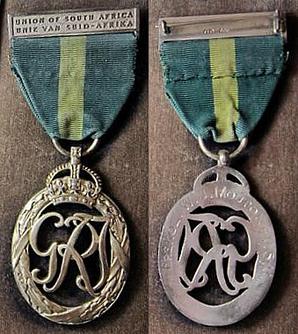
The Efficiency Decoration (South Africa), post-nominal letters ED, was instituted in 1930 for award to efficient and thoroughly capable part-time officers in the Citizen Force of the Union of South Africa after twenty years of service. The decoration superseded the Colonial Auxiliary Forces Officers' Decoration.

The Royal Naval Volunteer Reserve Long Service and Good Conduct Medal, initially designated the Royal Naval Volunteer Reserve Long Service Medal, was instituted in 1908. It could be awarded to part-time ratings in the United Kingdom's Royal Naval Volunteer Reserve after twelve years of service and good conduct. The medal was a Naval version of the Volunteer Long Service Medal and its successor, the Territorial Force Efficiency Medal.

The Permanent Forces of the Empire Beyond the Seas Medal is a long service and good conduct medal, instituted for award to other ranks of the Permanent Forces of the Dominions and Colonies of the British Empire. The medal, also known as the Permanent Overseas Forces Long Service and Good Conduct Medal, was established in 1910 as a single common award to supersede the several local versions of the Army Long Service and Good Conduct Medal which were being awarded by the various territories.

The Volunteer Long Service Medal was instituted in 1894 as an award for long service by other ranks and some officers of the United Kingdom's Volunteer Force. Award of the medal was discontinued when it was superseded by the Territorial Force Efficiency Medal in 1908.

The Medal for Long Service and Good Conduct (South Africa) (Medalje vir Langdurige Diens en Goeie Gedrag) is a distinctive South African version of the British Medal for Long Service and Good Conduct (Military). It was awarded to members of the Permanent Force of the Union of South Africa who had completed eighteen years of reckonable service.

The Army Long Service and Good Conduct Medal was instituted by King William IV in 1830. The medal remained in use for 100 years, until it was replaced by the Medal for Long Service and Good Conduct (Military) in 1930. During that time the reverse of the medal remained virtually unchanged, while the design of the obverse was altered during the reigns of Queen Victoria, King Edward VII and King George V.

In May 1895, Queen Victoria authorised Colonial governments to adopt various British military medals and to award them to members of their local permanent military forces. The Cape of Good Hope introduced this system in September 1895 and, in 1896, instituted the Meritorious Service Medal (Cape of Good Hope).

The Colonial Auxiliary Forces Long Service Medal was instituted by Queen Victoria in 1899 as a military long service award for part-time members of all ranks in any of the organized military forces of the British Colonies, Dependencies and Protectorates throughout the British Empire. The medal gradually superseded the Volunteer Long Service Medal for India and the Colonies in all these territories, with the exception of the Isle of Man, Bermuda and the Indian Empire.

In May 1895, Queen Victoria authorised Colonial governments to adopt various British military medals and to award them to members of their local permanent military forces. The Colony of Natal introduced this system in August 1895 and, in 1897, instituted the Meritorious Service Medal (Natal).

In May 1895, Queen Victoria authorised Colonial governments to adopt various British military medals and to award them to their local permanent military forces. The Cape of Good Hope and Colony of Natal instituted their own territorial versions of the Meritorious Service Medal in terms of this authority. These two medals remained in use in the respective territories until after the establishment of the Union of South Africa in 1910.

The Volunteer Officers' Decoration was instituted in 1892 as an award for long and meritorious service by officers of the United Kingdom's Volunteer Force. In 1894, the grant of the decoration was extended to commissioned officers of Volunteer Forces throughout the British Empire. A separate new decoration was instituted, the Volunteer Officers' Decoration for India and the Colonies, post-nominal letters VD.

The Volunteer Long Service Medal was instituted in 1894 as an award for long service by other ranks and some officers of the United Kingdom's Volunteer Force. In 1896, the grant of the medal was extended to other ranks and officers who had served in the ranks of the Volunteer Forces throughout the British Empire. A separate new medal was instituted, the Volunteer Long Service Medal for India and the Colonies. Awarding of this medal was discontinued in stages when it was superseded in most territories by the Colonial Auxiliary Forces Long Service Medal in 1899 and in the remainder by the Efficiency Medal in 1930.






















